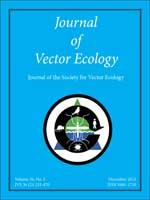House flies (Musca domestica) infected with Musca domestica salivary gland hypertrophy virus (MdSGHV) were found in fly populations collected from 12 out of 18 Danish livestock farms that were surveyed in 2007 and 2008. Infection rates ranged from 0.5% to 5% and averaged 1.2%. None of the stable flies (Stomoxys calcitrans), rat-tail maggot flies (Eristalis tenax) or yellow dung flies (Scathophaga stercoraria) collected from MdSGHV-positive farms displayed characteristic salivary gland hypertrophy (SGH). In laboratory transmission tests, SGH symptoms were not observed in stable flies, flesh flies (Sarcophaga bullata), black dump flies (Hydrotaea aenescens), or face flies (Musca autumnalis) that were injected with MdSGHV from Danish house flies. However, in two species (stable fly and black dump fly), virus injection resulted in suppression of ovarian development similar to that observed in infected house flies, and injection of house flies with homogenates prepared from the salivary glands or ovaries of these species resulted in MdSGHV infection of the challenged house flies. Mortality of virus-injected stable flies was the highest among the five species tested. Virulence of Danish and Florida isolates of MdSGHV was similar with three virus delivery protocols, as a liquid food bait (in sucrose, milk, or blood), sprayed onto the flies in a Potter spray tower, or by immersiion in a crude homogenate of infected house flies. The most effective delivery system was immersion in a homogenate of ten infected flies/ml of water, resulting in 56.2% and 49.6% infection of the house flies challenged with the Danish and Florida strains, respectively.
How to translate text using browser tools
1 December 2011
Salivary Gland Hypertrophy Virus of House Flies in Denmark: Prevalence, Host Range, and Comparison with a Florida Isolate
C. J. Geden,
T. Steenberg,
V.-U. Lietze,
D. G. Boucias
ACCESS THE FULL ARTICLE
It is not available for individual sale.
This article is only available to subscribers.
It is not available for individual sale.
It is not available for individual sale.

Journal of Vector Ecology
Vol. 36 • No. 2
December 2011
Vol. 36 • No. 2
December 2011
house fly
Musca domestica
salivary gland
stable fly
Stomoxys calcitrans
virus




